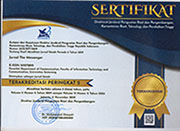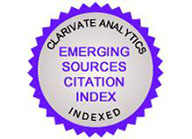The Impact of Chatbots on the Relationship between Integrated Marketing Communication and Online Purchasing Behavior in The Frontier Market
Abstract
Artificial Intelligence (AI), applied in many fields, is the core of the fourth technological revolution. In business, AI is used for customer relationship management as applied in the autoresponder systems, i.e., chatbot. Chatbots were an essential tool in the marketing relationship as many companies applied this function to their website; hence, this study analyzed the influence of chatbots on the enterprise's integrated marketing communication (IMC) activities, resulting in impulse purchase behavior and repurchase intention behavior. The mixed research method was used, particularly the in-depth interview and the survey with 886 online consumers, who shop from the online websites with chatbots system in Vietnam as Tiki, Lazada, Sendo, excetera. The research results showed that the perceived usefulness and ease of use of chatbots have positively affected the attitude of online consumers to the IMC activities of businesses. Simultaneously, IMC leads to impulse buying as well as the repurchase intention behavior of customers. The study proposed some managerial implications for an online business to enhance the chatbot functions to consumer behaviors in the website.
Keywords
Full Text:
PDFReferences
Al Khattab, S. A., As ad, H., & Zaidan, G. M. (2015). E-Integrated Marketing Communication and its impact on customers' attitudes. American Journal of Industrial and Business Management, 5(08), 538-547.
Beatty, S. E., & Ferrell, M. E. (1998). Impulse buying: Modeling its precursors. Journal of Retailing, 74(2), 169-191.
Boonlertvanich, K. (2011). Effect of customer perceived value on satisfaction and customer loyalty in banking service: The moderating effect of main bank status. International Journal of Business Research, 11(6), 40-54.
Brandtzaeg, P. B., & F ¸lstad, A. (2017). Why people use chatbots. International Conference on Internet Science, Thessaloniki, Greece.
Bruhn, M., & Schnebelen, S. (2017). Integrated marketing communication from an instrumental to a customer-centric perspective. European Journal of Marketing, 51(3), 464-489. https://doi.org/10.1108/EJM-08-2015-0591
Butkouskaya, V., Llonch-Andreu, J., & Alarc ³n-del-Amo, M.-d.-C. (2020). Inter-Country Customer-Perspective Analysis of Strategic Antecedents and Consequences for Post-Purchase Behaviour in Integrated Marketing Communications (IMC). Journal of International Consumer Marketing, 1-16. https://doi.org/10.1080/08961530.2020.1731901
Chukhleb, M. (2020). The application chatbots in medical purposes. ¯ ·Ñ‹ º ² ÑÑ„ µÑ€ µ ¿Ñ€ ¾Ñ„ µÑÑ ¸ ¾ ½ ° »Ñ ½ ¾ ¹ º ¾ ¼ ¼Ñƒ ½ ¸ º °Ñ† ¸ ¸. €” • º °Ñ‚ µÑ€ ¸ ½ ±ÑƒÑ€ ³, 2020, 743-747.
Dai, H., & Palvi, P. C. (2009). Mobile commerce adoption in China and the United States: a cross-cultural study. ACM SIGMIS Database: the DATABASE for Advances in Information Systems, 40(4), 43-61.
Dana, L. P. (1994). A Marxist mini-dragon? Entrepreneurship in today's Vietnam. Journal of Small Business Management, 32(2), 95-102.
Davis, F. D. (1989). Perceived Usefulness, Perceived Ease of Use, and User Acceptance of Information Technology. MIS Quarterly, 13(3), 319-340. https://doi.org/10.2307/249008
Dawar, N., & Bendle, N. (2018). Marketing in the age of Alexa. Harvard Business Review, 96(3), 80-86.
Eckstein, A., Chao, K., & Chang, J. (1974). The economic development of Manchuria: the rise of a frontier economy. The Journal of Economic History, 239-264.
Finne, …., & Gr ¶nroos, C. (2009). Rethinking marketing communication: From integrated marketing communication to relationship communication. Journal of Marketing Communications, 15(2-3), 179-195.
Fornell, C. (1992). A national customer satisfaction barometer: The Swedish experience. Journal of Marketing, 56(1), 6-21.
Hair, J. F., Hauff, S., Hult, G. T. M., Richter, N. F., Ringle, C. M., & Sarstedt, M. (2017). Partial Least Squares Strukturgleichungsmodellierung. Sage publications. https://doi.org/10.15358/9783800653614
Hair, J. F., Sarstedt, M., Ringle, C. M., & Gudergan, S. P. (2017). Advanced issues in partial least squares structural equation modeling. Sage Publications. https://doi.org/10.1007/978-3-319-05542-8_15-1
Hair Jr, J. F., Hult, G. T. M., Ringle, C., & Sarstedt, M. (2016). A primer on partial least squares structural equation modeling (PLS-SEM). Sage publications.
Hamza, V. (2013). A study on the mediation role of customer satisfaction on customer impulse and involvement to word of mouth and repurchase intention. International Journal of Business Insights & Transformation, 7(1), 62-67.
Kane, D. A. (2016). The role of chatbots in teaching and learning. In R. Scott & N. G. Margaret (Eds.), E-Learning and the Academic Library: Essays on Innovative Initiatives. McFarland & Company.
Kerr, W. R. (2008). Ethnic scientific communities and international technology diffusion. The Review of Economics and Statistics, 90(3), 518-537.
Khoa, B. T. (2020a). The Antecedents of Relationship Marketing and Customer Loyalty: A Case of the Designed Fashion Product. Journal of Asian Finance, Economics and Business, 7(2), 195-204. https://doi.org/10.13106/jafeb.2020.vol7.no2.195
Khoa, B. T. (2020b). Electronic Loyalty in the Relationship between Consumer Habits, Groupon Website Reputation, and Online Trust: A Case of the Groupon Transaction. Journal of Theoretical and Applied Information Technology, 98(24), 3947-3960.
Khoa, B. T. (2020c). The Perceived Enjoyment of the Online Courses in Digital Transformation Age: The Uses - Gratification Theory Approach 2020 Sixth International Conference on e-Learning (econf), Sakheer, Bahrain. https://ieeexplore.ieee.org/document/9385490/. https://doi.org/10.1109/econf51404.2020.9385490
Khoa, B. T. (2020d). The role of Mobile Skillfulness and User Innovation toward Electronic Wallet Acceptance in the Digital Transformation Era. 2020 International Conference on Information Technology Systems and Innovation (ICITSI), Bandung - Padang, Indonesia. https://doi.org/10.1109/ICITSI50517.2020.9264967
Khoa, B. T., Ha, N. M., & Ngoc, B. H. (2022). The Accommodation Services Booking Intention Through the Mobile Applications of Generation Y: An Empirical Evidence Based on TAM2 Model. In N. Ngoc Thach, D. T. Ha, N. D. Trung, & V. Kreinovich (Eds.), Prediction and Causality in Econometrics and Related Topics (pp. 559-574). Springer International Publishing. https://doi.org/10.1007/978-3-030-77094-5_43
Khoa, B. T., Hung, B. P., & Mohsen, H. (2022). Qualitative Research in Social Sciences: Data Collection, Data Analysis, and Report Writing. International Journal of Public Sector Performance Management, 9(4). https://doi.org/10.1504/ijpspm.2022.10038439
Khoa, B. T., Huynh, L. T., & Nguyen, M. H. (2020). The Relationship between Perceived Value and Peer Engagement in Sharing Economy: A Case Study of Ridesharing Services. Journal of System and Management Sciences, 10(4), 149-172. https://doi.org/10.33168/JSMS.2020.0210
Khoa, B. T., Ly, N. M., Uyen, V. T. T., Oanh, N. T. T., & Long, B. T. (2021). The impact of Social Media Marketing on the Travel Intention of Z Travelers. 2021 IEEE International IOT, Electronics and Mechatronics Conference (IEMTRONICS), Toronto, ON, Canada. https://doi.org/10.1109/IEMTRONICS52119.2021.9422610
Khoa, B. T., Nguyen, H. M., Tran, N. V. H., & Nguyen, B. H. (2020). Lecturers' adoption to use the online Learning Management System (LMS): Empirical evidence from TAM2 model for Vietnam. Journal of Science Hcmcou - Economics & Business Administration, 10(1), 3-17. https://doi.org/10.46223/HCMCOUJS.econ.en.10.1.216.2020
Khoa, B. T., Nguyen, T. D., & Nguyen, V. T.-T. (2020). The intention to purchase designed fashion product of Vietnamese Designer: The mediator of customer relationship. Journal of Business and Retail Management Research, 14(2), 22-32. https://doi.org/10.24052/JBRMR/V14IS02/ART-03
Kotler, P., Keller, K. L., Goodman, M., Brady, M., & Hansen, T. (2019). Marketing management (4th ed.). Pearson Education.
Lee, D. H., & Park, C. W. (2007). Conceptualization and measurement of multidimensionality of integrated marketing communications. Journal of Advertising Research, 47(3), 222-236.
Lee, E.-J. (2011). The effects of internet fashion consumer's impulse buying tendency on positive and negative purchasing behaviors. Fashion & Textile Research Journal, 13(4), 511-522.
Lee, M.-C. (2009). Factors influencing the adoption of internet banking: An integration of TAM and TPB with perceived risk and perceived benefit. Electronic Commerce Research and Applications, 8(3), 130-141.
Li, C.-H., Yeh, S.-F., Chang, T.-J., Tsai, M.-H., Chen, K., & Chang, Y.-J. (2020). A Conversation Analysis of Non-Progress and Coping Strategies with a Banking Task-Oriented Chatbot. Proceedings of the 2020 CHI Conference on Human Factors in Computing Systems,
Lim, S. H., & Kim, D. J. (2020). Does Emotional Intelligence of Online Shoppers Affect Their Shopping Behavior? From a Cognitive-Affective-Conative Framework Perspective. International Journal of Human Computer Interaction, 1-10.
Liu, Y., Li, H., & Hu, F. (2013). Website attributes in urging online impulse purchase: An empirical investigation on consumer perceptions. Decision support systems, 55(3), 829-837.
Luan, W. S., & Teo, T. (2009). Investigating the technology acceptance among student teachers in Malaysia: An application of the technology acceptance model (TAM). The Asia-Pacific Education Researcher, 18(2), 261-272.
Mehrabian, A., & Russell, J. A. (1974). An approach to environmental psychology. M.I.T. Press.
Moon, S.-J., Costello, J. P., & Koo, D.-M. (2017). The impact of consumer confusion from eco-labels on negative WOM, distrust, and dissatisfaction. International Journal of Advertising, 36(2), 246-271.
Morgan Stanley Capital International. (2020). MSCI announces the results of the 2020 annual market classification review. Retrieved May 21st from https://www.msci.com/market-classification
Narver, J. C., & Slater, S. F. (1990). The effect of a market orientation on business profitability. Journal of Marketing, 54(4), 20-35.
Ndubisi, N. O., Malhotra, N. K., & Wah, C. K. (2008). Relationship marketing, customer satisfaction and loyalty: a theoretical and empirical analysis from an Asian perspective. Journal of International Consumer Marketing, 21(1), 5-16.
Nguyen, M. H., & Khoa, B. T. (2021). The Google Advertising Service Adoption Behavior of Enterprise in the Digital Transformation Age. Webology, 18(Special Issue on Information Retrieval and Web Search), 153-170. https://doi.org/10.14704/web/v18si02/web18064
Peltier, J. W., Schibrowsky, J. A., & Schultz, D. E. (2003). Interactive integrated marketing communication: combining the power of IMC, the new media and database marketing. International Journal of Advertising, 22(1), 93-115.
Reichheld, F. F., & Schefter, P. (2000). E-loyalty: your secret weapon on the web. Harvard Business Review, 78(4), 105-113.
Rietz, T., Benke, I., & Maedche, A. (2019). The impact of anthropomorphic and functional chatbot design features in enterprise collaboration systems on user acceptance.
Rook, D. W. (1987). The buying impulse. Journal of Consumer Research, 14(2), 189-199.
Rook, D. W., & Hoch, S. J. (1985). Consuming impulses. ACR North American Advances.
Rouhiainen, L. (2018). Artificial Intelligence: 101 things you must know today about our future. Amazon Asia-Pacific Holdings.
Schneider, R. R. (1995). Government and the Economy on the Amazon Frontier. The World Bank.
Schultz, D. (2016). The future of advertising or whatever we're going to call it. Journal of advertising, 45(3), 276-285.
Schultz, D., Chu, G., & Zhao, B. (2016). IMC in an emerging economy: the Chinese perspective. International Journal of Advertising, 35(2), 200-215.
Smutny, P., & Schreiberova, P. (2020). Chatbots for learning: A review of educational chatbots for the Facebook Messenger. Computers & Education, 151. https://doi.org/10.1016/j.compedu.2020.103862
Trips, R. (2017). How chatbots can help reduce customer service costs by 30%. Retrieved May 04th from https://www.ibm.com/blogs/watson/2017/10/how-chatbots-reduce-customer-service-costs-by-30-percent
Van den Broeck, E., Zarouali, B., & Poels, K. (2019). Chatbot advertising effectiveness: When does the message get through? Computers in Human Behavior, 98, 150-157.
Villarreal, R. (2010). Integrated Marketing Communication Strategy. Wiley International Encyclopedia of Marketing.
Viswanath Prakash, A., & Das, S. (2020). Would you Trust a Bot for Healthcare Advice? An Empirical Investigation. PACIS 2020 Proceedings,
Vova, C. (2019). Chatbots: A new way to communicate with your customers. Retrieved May 12th from https://chatbotslife.com/chatbots-a-new-way-to-communicate-with-your-customers-e1ed3596c04f
Wagner Mainardes, E., de Almeida, C. M., & de-Oliveira, M. (2019). e-Commerce: an analysis of the factors that antecede purchase intentions in an emerging market. Journal of International Consumer Marketing, 31(5), 447-468.
Winkler, R., & Soellner, M. (2018). Unleashing the Potential of Chatbots in Education: A State-Of-The-Art Analysis. Academy of Management Annual Meeting (AOM), Chicago, USA.
Winkler, R., & S ¶llner, M. (2018). Unleashing the potential of chatbots in education: A state-of-the-art analysis Academy of Management Annual Meeting (AOM), Chicago, USA.
Wood, M. (2005). Discretionary unplanned buying in consumer society. Journal of Consumer Behaviour: An International Research Review, 4(4), 268-281.
Zarouali, B., Van den Broeck, E., Walrave, M., & Poels, K. (2018). Predicting consumer responses to a chatbot on Facebook. Cyberpsychology, Behavior, and Social Networking, 21(8), 491-497.
Zikmund, W. G., Carr, J. C., & Griffin, M. (2013). Business Research Methods. South-Western Cengage Learning.
DOI: http://dx.doi.org/10.26623/themessenger.v13i1.2439
Refbacks
- There are currently no refbacks.
Copyright (c) 2021 Jurnal The Messenger
View My Stats [Jurnal The Messenger] is an International Scientific Journal, Published by the Department of Communication, Faculty of Information Technology and Communication, Universitas Semarang (Central Java, Indonesia). It is licensed under a Creative Commons Attribution 4.0 International License.



_11.jpg)




_BARCODE.jpg)
_BARCODE1.jpg)



5.png)










2.png)





